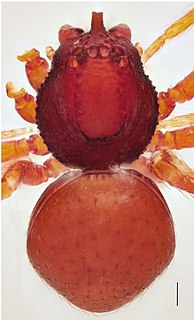
Tetrablemmidae, sometimes called armored spiders, is a family of tropical araneomorph spiders first described by Octavius Pickard-Cambridge in 1873. It contains 126 described species in 29 genera from southeast Asia, with a few that occur in Africa and Central and South America. Pacullidae was incorporated into this family in 1981, but was later restored as a separate family in a 2016 phylogenetic study.
Pacullidae is a family of araneomorph spiders first described by Eugène Simon in 1894. It was merged into Tetrablemmidae in 1958, then raised back to family status after a large phylogenetic study in 2017.

Tetrablemma is a widespread genus of armored spiders first described by Octavius Pickard-Cambridge in 1873. It only has four eyes; an unusual trait for spiders, found only here and in some species of Caponiidae, though the two are not closely related. The eyes are large, but unequal in size, closely grouped around the center of the prosoma that rises in a somewhat of a cone shape from the abdomen. They have four closely positioned spinnerets enclosed in a corneous casing.

Brignoliella is a genus of araneomorph spiders in the family Tetrablemmidae that was first described by W. A. Shear in 1978.
Gunasekara is a monotypic genus of Sri Lankan araneomorph spiders in the family Tetrablemmidae containing the single species, Gunasekara ramboda. It was first described by Pekka T. Lehtinen in 1981, and is found in Sri Lanka.
Pahanga is a genus of Asian araneomorph spiders in the family Tetrablemmidae that was first described by W. A. Shear in 1979.
Shearella is a genus of Asian araneomorph spiders in the family Tetrablemmidae that was first described by Pekka T. Lehtinen in 1981.
Tetrablemma medioculatum is a species of spider of the genus Tetrablemma. The nominate subspecies is endemic to Sri Lanka. Two other subspecies can be found, both of which are endemic to India.
Afroblemma is a monotypic genus of African araneomorph spiders in the family Tetrablemmidae containing the single species, Afroblemma thorelli. It was first described by Pekka T. Lehtinen in 1981, and is found in Africa.
Anansia is a monotypic genus of Angolan araneomorph spiders in the family Tetrablemmidae containing the single species, Anansia astaroth. It was first described by Pekka T. Lehtinen in 1981, and is found in Angola.
Caraimatta is a genus of araneomorph spiders in the family Tetrablemmidae that was first described by Pekka T. Lehtinen in 1981.
Hexablemma is a monotypic genus of araneomorph spiders in the family Tetrablemmidae containing the single species, Hexablemma cataphractum. It was first described by Lucien Berland in 1920 from a female found in Kenya. It was separated from Tetrablemma in 1978 for this single species, because it doesn't belong there, but doesn't seem to belong anywhere else either.
Lamania is a genus of Southeast Asian araneomorph spiders in the family Pacullidae that was first described by Pekka T. Lehtinen in 1981. Originally placed with the armored spiders, it was moved to the Pacullidae in 2017.
Maijana is a monotypic genus of araneomorph spiders in the family Tetrablemmidae containing the single species, Maijana rackae. It was first described by Pekka T. Lehtinen in 1981 from a single female found in bat guano in a Javanese cave of the Bogor Regency. Though it looks similar to Tetrablemma species, the structural parts, namely the epigyne, are unique enough to differentiate them.
Mariblemma is a monotypic genus of araneomorph spiders in the family Tetrablemmidae found on the Seychelles. It contains the single species, Mariblemma pandani, first described by Paolo Brignoli in 1978 and placed into Paculla. Pekka T. Lehtinen transferred it to Mariblemma in 1981, disagreeing with Brignoli's original placement.
Micromatta is a monotypic genus of Central American araneomorph spiders in the family Tetrablemmidae found in Belize. It contains the single species, Micromatta atoma, first described by W. A. Shear in 1978. Pekka T. Lehtinen transferred it to Micromatta in 1981 because the shapes of the male embolus and conductor are quite different than those of Matta and Caraimatta. Additionally, the plesiomorphic structure of pedipalp segments prove that the three genera aren't a paraphyletic group.
Singalangia is a monotypic genus of Sumatran araneomorph spiders in the family Tetrablemmidae containing the single species, Singalangia sternalis. It was first described by Pekka T. Lehtinen in 1981, and is found on Sumatra.
Singaporemma is a genus of Asian araneomorph spiders in the family Tetrablemmidae that was first described by W. A. Shear in 1978.
Sulaimania is a genus of Southeast Asian araneomorph spiders in the family Tetrablemmidae that was first described by Pekka T. Lehtinen in 1981. As of September 2019 it contains two species, found in Malaysia and Singapore: S. brevis and S. vigelandi.


